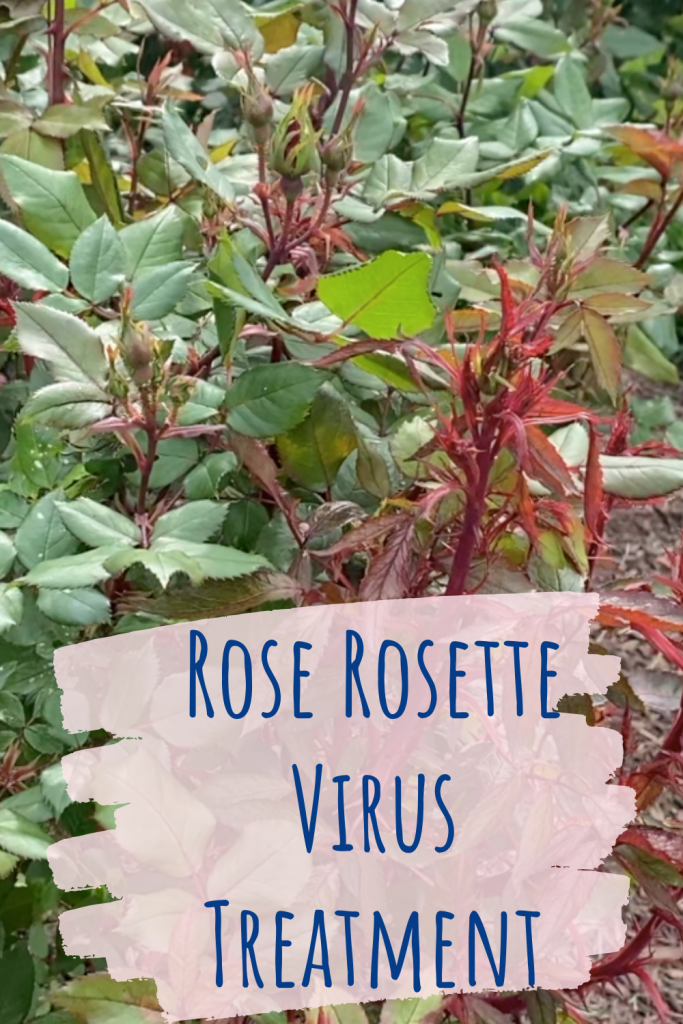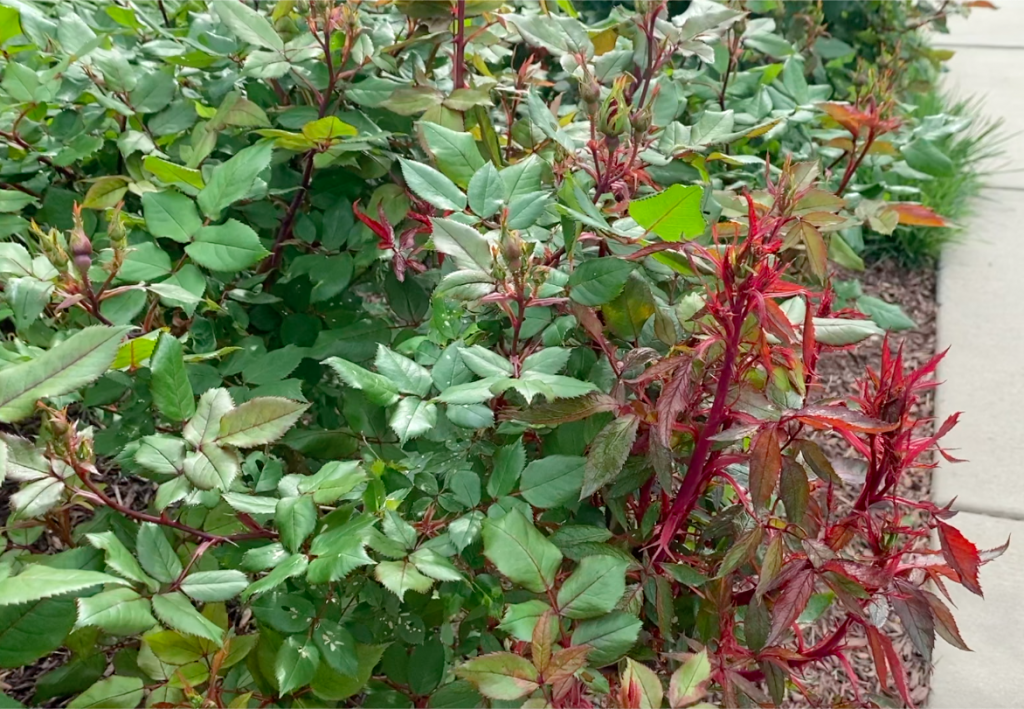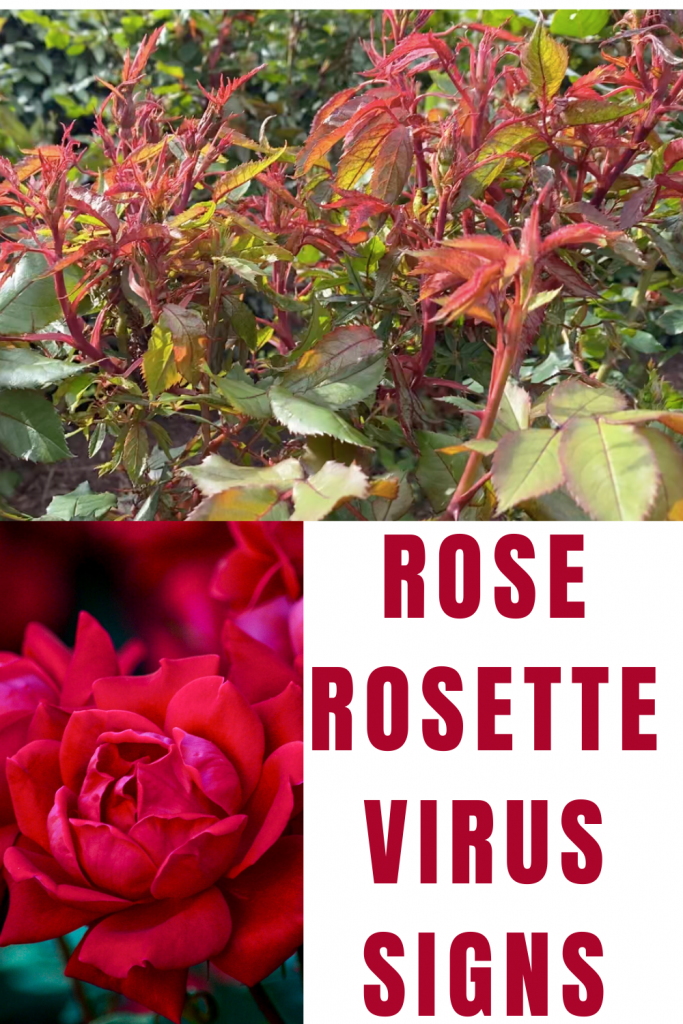
If you have been following me on social media you’ve seen how my roses have been plagued by the dreaded rose rosette disease, which is caused by the rose rosette virus. I first saw these on one of the roses in my knockout rose hedge.

Later that year a white drift rose, that used to be in the place of the pink yarrow in the below picture fell prey to this virus.

This year another knockout rose from the above hedge was infected, which was soon followed by the middle one in this drift rose border below. We ended up removing all of the below roses for fear that it might spread to the ones nearby.

Lately, I have also noticed that a lot of the knockouts in our community are infected. Sadly most of the landscapers that work here are either unaware or don’t care about this, which results in the disease spreading, infecting all the other roses in the area. As always the first step to curb the spread is to educate everyone about the disease, how to spot, and how to treat it. Hence this post and video tutorial.
The disease is spread by a very tiny mite called the eriophyid mite, which travels from one plant to another. The mite is so tiny that it is often carried by the wind, putting any nearby rose bushes at risk. Usually the host plant for the virus is a multiflora rose, which is an invasive rose, that is very common in our woodlands here in VA.
How can you spot the rose rosette disease?
- Dark red new growth, which is oddly formed and does not turn green over time
- Cluster of small deformed branches and flower buds coming out of a new growth or Witches Broom (a tell tale sign)
- Thick stems with excessive thorns
- Deformed or elongated leaves
- Stunted or deformed flowers
An infected plant may exhibit one or more symptoms of the disease. The common ones I have seen are the dark red new growth which refuses to turn green with time, witches broom, and excessive thorns. People always get confused by the red growth as it is very normal for new growth on a rose to look red. In the below photo, the buds you see on the left are a good example of good new growth while the red buds on the right are a sign that this plant is infected with the rose rosette disease.

What is the treatment for an RRV infected rose?
Unfortunately there really is no treatment. You have to remove the entire plant before the mites on the infected plant spread to another one close by. Pruning just the infected stems is not recommended as the virus might have already spread to other parts of the plant, even though there are no visible signs elsewhere on the plant.
Are there any preventive measures you can take?
Yes, there are a few that will reduce the chance of a rose getting infected with this disease.
- When planting a rose hedge make sure that the bushes are not very close to each other. This will deter the mite from travelling from one plant to the next.
- Prune the roses in late winter or spring aggressively. This will ensure that any mite eggs that overwinter in the bushes are eliminated
- As soon as you spot the disease remove the whole plant
- Clean the tools you use to prune or dig the plant out with a diluted bleach solution (this is more of a safety measure as latest research indicate that the mites don’t spread via tools used on an infected bush)
- Do not plant a rose in the same spot as an infected rose for the next 3-4 years. Latest research has shown that the virus does not survive in the soil however most often some roots of the infected plant are left behind. Because of this there is a high chance that the virus in those roots will infect a nearby rose plant.
As you can see in the video this problem is very prevalent here in zone 6b in VA and unfortunately I don’t see it going away anytime soon. Between the Japanese Beetles, humidity related issues like the black spot, rose sawfly, and now this rose rosette virus, it is becoming extremely hard for us to grow roses here. What a shame as these gorgeous beauties deserve a prominent place in every garden! Do you have the rose rosette disease in your neck of the woods?





We recently had several rose bushes diagnosed with the virus here in Delaware. It’s a very bizarre disease because it deforms sections of the bush whilst growing normal on other sections. To my knowledge this is temporary and eventually the bush will be taken over entirely. We intend on removing them but it’s difficult to part with them as we’ve put so much TLC into them, but we have about 15 bushes on the property and only 4 appear to be infected, so it’s probably in our best interest to remove them ASAP.
There’s a website that will diagnose the virus for you if you send them pictures of the deformations, This is how I diagnosed mine as well. The address is https://roserosette.org/reporting/
You can also see the locations that have reported it at
https://www.eddmaps.org/midwest/distribution/viewmap.cfm?sub=4248
Oh my. So sorry to hear about your roses. They do spread fast. I’m guarding my David Austins like a hawk.Thank you for the reporting link.
I’ve removed 7 of my rose bushes due to this virus. I am in Lubbock Texas.
Sadly with no treatment I opted to remove them. It’s a horrible disfiguring disease.
If the virus is transmitted via a mite, is there a miticide that could be a preventative?
Unfortunately no.
Thank you for this helpful video! Unfortunately, though I’m somewhat in denial, I think at least one of my knockout roses must have RRD.
Can totally understand. I lost 5 more roses last Fall and this Spring.
I just discovered what is going on in my rose hedge (25 knockout roses around pool ) and I am sick! This hedge is 5 years old and absolutely beautiful when in full bloom.
I have other rose gardens on the property and am planning to remove the entire hedge and hope that the virus/mites haven’t spread around the property.
I am sure that my 9 knockout roses have this. There are other plants in the same bed. Will they be ok? Also have 3 drift roses in the same bed but not touching the knockouts. Do I go ahead a remove them or cut back and treat them. Will the other plants be ok and also the drift roses? I have another bed with knockouts and they seem ok but they are not far away from the diseased ones. What should I do as we are going into the fall season? Thanks, Janet Staed
You only need to remove the infected roses. RRV affects only roses so other plants are safe.
I have about 10 knock out bushes. I live in Amarillo tx. I noticed it earlier in the year and kept spraying with neem oil and fungicide. I found that it was Rosetta chopped the 3 bushes that ha it all the way to ground almost. I thought I could maybe save the others but sounds like it takes awhile to show up. Sad I’m probably going to loose my plants. Thank you for sharing this info.
I identified two infected roses in the bed. Do I need to remove the rest of 10 roses in the same bed near by the infected roses?
No you don’t need to unless they are also infected.